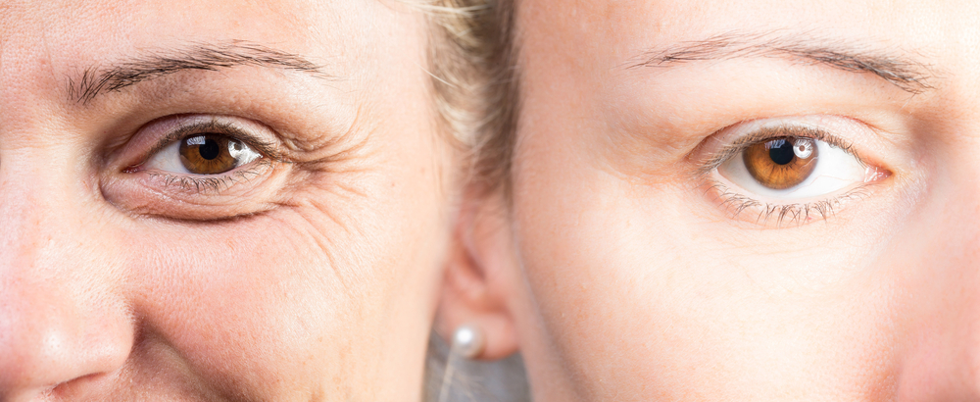Blepharoplasty (eyelid surgery)
Published on: 16 Sep 2019, 2:20 p.m.
Mr Debashis Ghosh
NHS Consultant
GMC Number: 4657664

Medically reviewed by a licensed NHS consultant
Last updated: 15/08/2019Get Free & Simple Pricing, Procedure & After Care Information from a Licensed Consultant Now
Blepharoplasty (eyelid surgery)
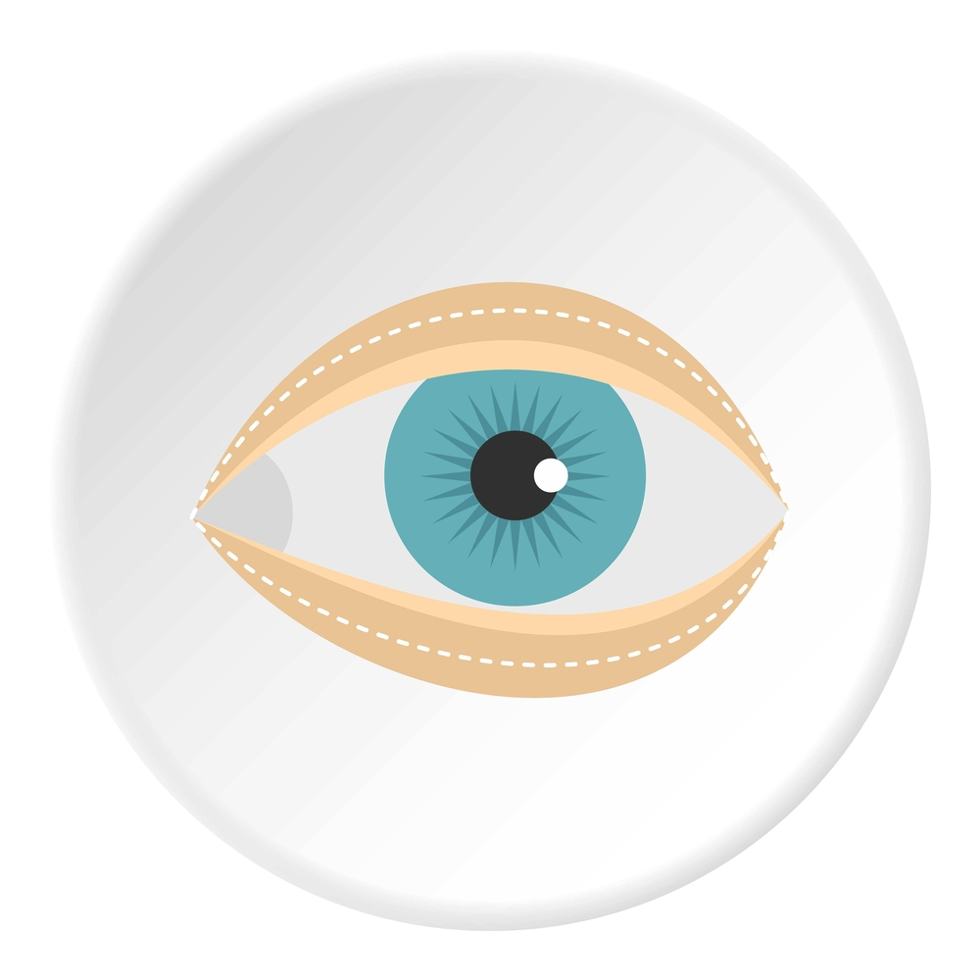
Cosmetic eye surgery can be complicated, especially because there are many different procedures and techniques associated with the surgery. Here’s an easy guide explaining everything you need to know about Blepharoplasty.
PhotoCredit: Rvector/ShutterStock
Blepharoplasty (pronounced BLEF-uh-roe-plas-tee) is often referred to as eyelid surgery/eyelift surgery. Blepharoplasty is the surgical solution for droopy eyelids.
It is one of the most popular facial plastic surgery procedures.
Blepharoplasty surgery is used for both functional and cosmetic reasons. The procedure is more common in women, with women accounting for 88% of the total number of surgeries in the UK.
Blepharoplasty can treat the upper or lower eyelids (or both), depending on the patient’s needs. The procedure typically involves removing excess skin and muscle from these areas and either reducing or repositioning the underlying fat to give a more youthful configuration.
This guide has been made to help decide if blepharoplasty is right for you, to find out what you can realistically expect and to explore the benefits and risks of blepharoplasty.
Why is Blepharoplasty performed?
Blepharoplasty is carried out for cosmetic and functional reasons.
Blepharoplasty surgery is usually cosmetically performed to resolve the ‘tired’ look. People who suffer with heavy eyelids and bags give the appearance of being constantly exhausted and tired. Blepharoplasty surgery creates a fresher, younger and more natural looking face. It is a popular cosmetic surgery as the procedure is low risk, but the outcome can be dramatic.
Blepharoplasty can also be cosmetically performed to help improve the appearance of asymmetrical eyelids, making them more symmetrical.
Furthermore, conditions such as thyroid eye disease can cause disfigurations in the face and eyes. Blepharoplasty surgery can help restore the natural appearance of the eyes.
However, some people undergo blepharoplasty for functional reasons.
Medical conditions such as Dermatochalasis can cause the eyelids to sag obstructing the visual field (patients can often not see the full extent of their lateral vision). Blepharoplasty removes this obstruction improving patients’ vision.
Upper vs Lower Blepharoplasty
Blepharoplasty can be performed on the upper and lower eyelids (depending on where your problem area is).
Upper Lid Blepharoplasty Procedure
Upper blepharoplasty is used to get rid of the excess skin that can overhang on lashes, and it reduces unwanted fullness.
Lower Lid Blepharoplasty Procedure
Lower eyelid surgery is used when patients have large bags and/or puffiness under the eyes. This is often worsened by aging with the eye muscle deteriorating allowing for fat deposits to shift, resulting in the under-eye area appearing dark and puffy. With the lower lid blepharoplasty surgeons often remove the unwanted fat in the lower lids (as performed in the upper eyelid) but can also transfer it to areas in the cheek that is hollow to further improve on the results.
Is It Safe to Undergo Both Upper/Lower Blepharoplasty Surgeries at the Same Time?
It is safe to undergo both upper and lower blepharoplasty. Patients often choose to undergo both at the same time as it reduces the time needed to recover.
Contrary to popular belief, having the two surgeries together adds no greater risk. Though ultimately it is the patient’s choice to decide if they want to have both procedures.
What is the difference between a traditional Blepharoplasty VS. other Blepharoplasty and Ptosis Surgery?
Traditional blepharoplastyinvolves the use of a scalpel to make incisions and cut out excess skin/fat/tissue etc.
Advantages
• Dramatic change
• Natural looking
• Recovery is fairly easy and short.
• The eyes heal well.
• Increased and improved vision
Disadvantages
• Procedure may need to be repeated and the surgery doesn’t prevent the eyes from aging.
Laser blepharoplasty- a newer method, using a laser instead of a scalpel. Laser blepharoplasty can be used in two different ways:
The laser can actually be used to make the incisions, rather than using a scalpel, providing an alternative method than the traditional blepharoplasty.
1. The lasers create the incisions, and seals blood vessels immediately to prevent bleeding. This reduces the amount of blood lost, allowing for a quicker and easier surgery.
2. Alternatively, laser blepharoplasty can be used after the excess skin is removed to help "resurface" the skin. Tackling issues such as wrinkles, and elasticity and creating smooth looking skin. This type of laser surgery can be used with the laser method above or in conjunction with the traditional blepharoplasty surgery.
For the laser treatments, the two most commonly used are the erbium-YAG laser and the CO2 laser (most doctors will use both lasers during surgery).
• The erbium-YAG laser is usually used for resurfacing the skin
• The CO2 laser is the superior option for making the incisions
Advantages
• Reduced bleeding makes laser blepharoplasty surgery faster and easier for the surgeon
• Less bruising and swelling than traditional Blepharoplasty
Disadvantages
• Lasers (like the CO2 laser) are known to produce irreversible coagulative necrosis (cell death)- increasing the risk of scarring
Non-surgical Blepharoplasty (PLEXR)-PLEXR uses a special innovative PLEXR device so no incisions are needed.
The PLEXR device ionises air to form a plasma. It makes small dots in the skin to sublimate, (that is, change from a solid to a gas), the superficial skin cells around the eye. This stimulates the skin to contract, tightening fibres around the eye to give a more youthful appearance.
Advantages
• Treatment can be performed on any skin type.
• This procedure does not involve cutting the skin or stitches
• Faster healing process.
• Excellent alternative for those not ready for eyelid surgery, or for those who are not suitable for a surgical Blepharoplasty.
• No bleeding or damage to the surrounding tissue, especially to the important deeper layer of skin.
Disadvantages
• Areas treated will be red and swollen for a while.
• At the site of each dot, there will be a carbon crust that should not be touched and can look unsightly (until healed).
Ptosis surgery-This is a procedure made to deal with the condition ptosis (pronounced toe–sys).
Ptosis causes the upper eyelid to droop. Ptosis occurs due to a dysfunction of the muscles that raise the eyelid or their nerve supply. It can occur in both adults and children. The surgery is often performed alongside blepharoplasty.
Ptosis can be treated using a number of different operations. However, ptosis surgery usually involves shortening the muscles or tendons that raise the lid. The shortened muscle or tendon is reattached to your eyelid using sutures.
However, the lid is sometimes raised by suspending it from the brow. This is done by using tendons from your thigh or leg.
Advantages
• Increased visual field.
• An improvement in the quality of vision, especially the brightness
• Restoring the normal appearance of the lid
Disadvantages
• Eyelids may not appear symmetrical
• Very rarely, eyelid movement may be affected.
• Ptosis condition can reoccur. If it does, you may need to have a repeat surgery.
Your doctor will examine your condition and discuss the best option with you.
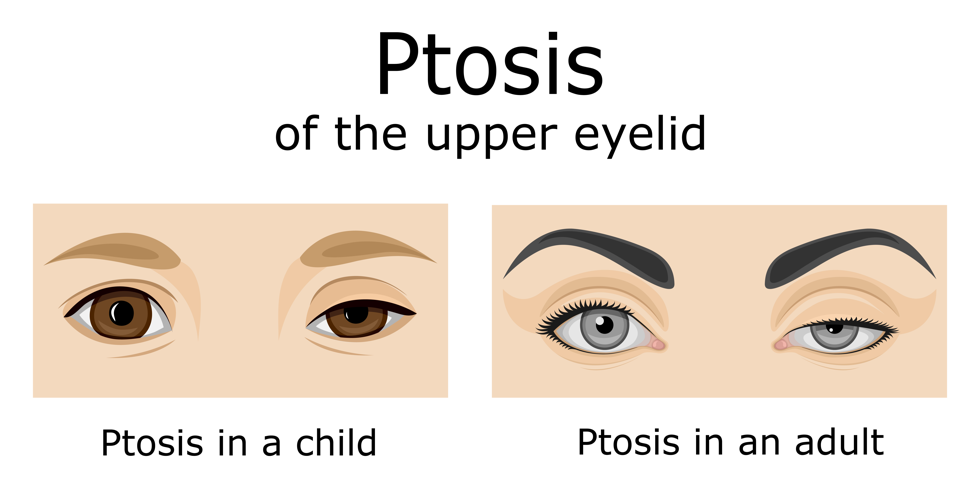
PhotoCredit: Scio21/ShutterStock
Blepharoplasty may be an option if you have:
• Baggy or droopy upper eyelids
• Excess skin of the upper eyelids that interferes with your vision
• Droopy lower eyelids
• Dark circles
• Excess skin on the lower eyelids
• Wrinkles round the eye
• Bags under your eyes
What preparations do I need before Blepharoplasty Surgery?
Before choosing blepharoplasty surgery you must discuss with your doctor:
• Your medical history. Your surgeon will need to ask questions about any past surgeries and any conditions you have or may have had such as dry eyes, allergies, diabetes, thyroid issues, glaucoma. They will also need to know about any medications you are currently taking, including herbal treatments and vitamin supplements and they may ask about any alcohol, drugs or tobacco use.
• Your expectations. It is important to be honest and discuss with your surgeon what you want to achieve from the surgery. They can advise you as to whether the procedure is likely to be successful and meet your expectations.
Before your surgery, you may have:
• A physical examination. Your surgeon will examine the area around your eyes. They may check whether or not you can produce tears. They may measure your eyelids.
• An eye tests Your eye doctor may test your vision, including your peripheral vision.
• Eyelid photography. Your eyes are usually photographed from different angles. This may help with planning the surgery and providing before and after photos.
The Blepharoplasty Procedure
Before
Blepharoplasty is usually done on an outpatient basis. Patients are usually injected with a small needle administering local anaesthesia (similar to injections given at the dentist); helping to numb the eyelids. Intravenous sedation is then given to help patients relax. However general anaesthesia can be used if the patients would prefer to be asleep during the surgery.
During
If you're having all four eyelids done, the surgeon will probably work on the upper lids first. The procedure involves making an incision at the natural crease of both upper eyelids. After which excess fat is removed or redistributed. Reversing issues with puffiness or dropping of the upper eyelid. The incisions are sewed together with stitches (lasting approximately 3-6 days). Making the eyelids appear tighter and smoother. If your upper eyelid droops close to your pupil, your surgeon may do blepharoplasty with ptosis surgery, which will provide additional support to the eyebrow muscle.
Surgery on the lower eyelids may be done using one of several techniques. For example, to remove excess fat, incisions are made either below the lash line of the lower lids (transcutaneous) or on the inside of the lower lids (transconjunctival). The lower lids may or may not require stitches, depending on the technique used. The transconjunctival technique, is rising in popularity as no external incision is made, leaving patients with no obvious scaring.
Once the fat is removed, laser resurfacing (laser blepharoplasty) is often used to help tighten the loose skin of the lower eyelids. Your surgeon can then soften fine lines in the skin using a CO2 or erbium laser.
After
Eyelift surgery takes approximately two hours if both upper and lower eyelids are treated.
After either of these procedures, your surgeon may recommend laser resurfacing to create smooth looking skin.
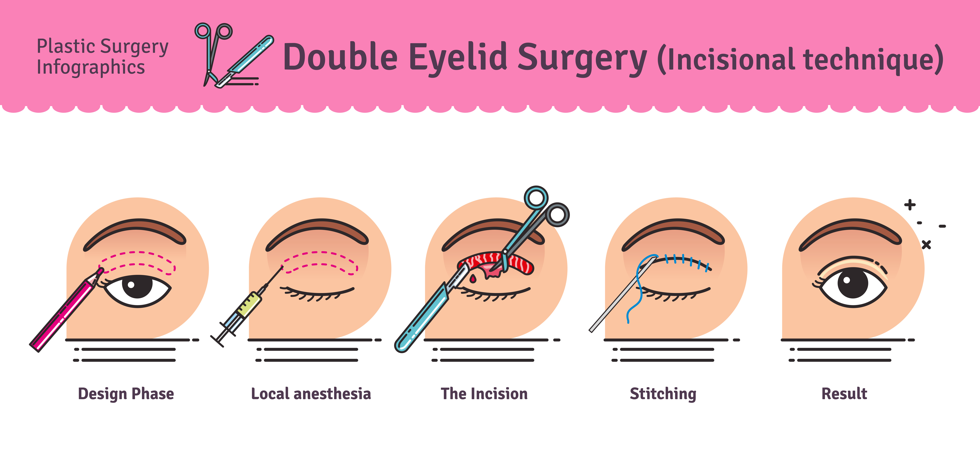
PhotoCredit: Ant_art/ShutterStock
Blepharoplasty side effects
After surgery you may experience:
• Temporary blurred vision from the lubricating ointment applied to your eyes
• Light sensitivity
• Swelling and bruising
• Bleeding
• Inflamed, itchy scars
• Dry or watery eyes
• Pain or discomfort - usually minimal
With any surgery other risks can sometimes occur, these include:
• Double vision
• Surgical risks such as bleeding or infection
• Blood clots that may cause potentially fatal cardiovascular complications
• Lumps inside the lower eyelid, which can irritate the eye surface
• Sunken or unnatural-looking eyes, if too much fat is removed
• Vision loss, in extreme cases complete blindness
Any surgery comes with risks and it's natural for patients to be concerned. However, blepharoplasty in general is an extremely common, safe procedure when performed by professionals.
Blepharoplasty before and after
Curious to see the effects Blepharoplasty surgery can have? Make sure you ask your surgeon to see their portfolio pictures to check their results are suited to you.
PhotoCredit: sruilk/ShutterStock
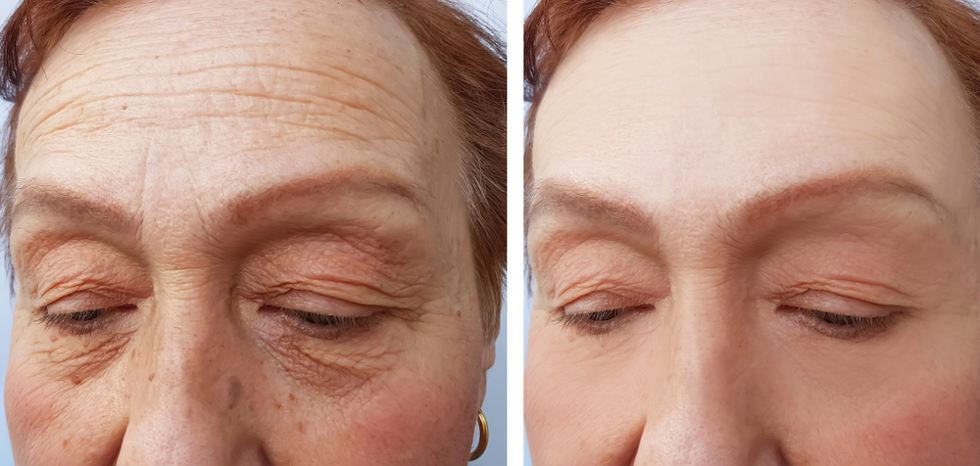
PhotoCredit: Tanya Lovus/ShutterStock
Blepharoplasty recovery
What to Expect after Eyelid Surgery?
Typically, patients who are given general anaesthesia and are asleep during the surgery take longer to heal.
In most cases, your eyelid surgery will be performed on an outpatient basis, so when your anaesthesia wears off you will be able to return home the same day. Once you awake, your vision will often be blurry due to the ointment applied to the eyelids. Don’t worry, this is the most common side effect and doesn’t mean your surgery has been unsuccessful. Doctors may also cover your eyes with a cool gauze which is recommended to be worn for three days post op. Your eyes may be watery, dry and/or sensitive to light.
It is important to have someone to pick you up, to help you get home and to stay with you for the first night. If this is not possible clinics can often organise someone to accompany, you – let them know if you will need this.
In the first 24 hours it is common to experience some pain and discomfort. Your eyes will most likely be swollen and may feel tight. Furthermore, you may have some bruising around the eyelids, which sometimes results in a black eye appearance. Don’t worry, this will fade. The severity of the swelling and bruising will vary for each individual.
The incision will often look pink whilst the wounds heal. Your eyelids may feel numb for several days.
Remember to be patient as your body recovers.
After Care
Medication such as aspirin should not be taken as they can increase your risk of bleeding. To speed up the healing process it is also advised not to smoke.
Any discomfort can be easily treated with over the counter pain relief medication. Or alternatively applying a cooling pack or frozen peas to the eyelids can reduce the pain and swelling (make sure anything applied to the eyes is clean and sterile). For the first 24 hours it is recommended you regularly apply a cooling pack to your eyes (10-15 mins on, 10-15 mins off).
It is essential patients rests in these first 24 hours. Keep your head still and elevated whilst sleeping to minimise the swelling/bruising. E.g. sleep with two pillows or large wedge-shaped pillow. Bruising and swelling will reduce overtime and vary depending on the operation. In general, if a patient undergoes an upper eyelid blepharoplasty bruising should decrease within 1-2 weeks. However, if both the upper and lower eyelid were treated on, it may take 2-4 weeks for the bruising/swelling to subside.
Avoid makeup for at least two weeks. Dark sunglasses are encouraged to be worn for the first couple of weeks (especially when outdoors), to protect the eye from any external interference (wind). During the first couple of weeks the eyes may become tired quickly, and regularly naps should be taken.
Gentle exercise can begin the day after surgery. However, strenuous exercise is should usually be avoided until three weeks post op. Your wounds must be fully healed before taking part in strenuous exercise as it causes your blood pressure to rise, increasing the chances of bleeding from your wounds. Crying should also be avoided if possible. There are different return times for different activities. For example, swimming is not recommended until at least 4 weeks post op, but cycling is allowed within 2 weeks (as long as protective wear is worn over the eyes.). Contact and extreme sports must be avoided for at least two months. Your doctor will inform you when your activities can be resumed.
To prevent the eye from becoming dry, artificial tear drops are prescribed. Doctors will also encourage patients to avoid spending excesses time on activities which can tire and dry out your eyes (at least for the first week). These include looking on your smartphone, computer, television and reading.
How Long is the Recovery Period?
Recovery from eyelid procedures is often relatively easy with moderate pain. In general, it takes several weeks for patients to fully recover from blepharoplasty surgery. However, most patients feel well enough to resume all normal activities after just a week.
Patients are encouraged to take at least 1-2 weeks off work. This gives you time to recover without any unnecessary stress.
Blepharoplasty results
You should be able to see your final results after about six weeks (although it can take longer). At this stage swelling and bruising should have subsided, and you shouldn’t be able to tell you just underwent surgery. At this point you will start to see your eyes in a new light. Your eyes will be brighter, younger and refreshed. The change on your face will be dramatic with your patience being rewarded.
For some people, results of surgery may last a lifetime. For others, droopy eyelids may reoccur.
Will the results of Eyelid Surgery Be Permanent?
In general, the results of blepharoplasty are permanent and of course once the fat is removed -it’s gone. However, some patients do suffer from reoccurring sagging. Usually upper eyelid surgery lasts for at least five to seven years, whereas lower eyelid surgery rarely needs to be repeated. Naturally, your eyes will still age after the procedure.
If your lids do happen to sag again, your doctor may recommend you a forehead lift instead of another eyelid procedure.
Speak to you doctor beforehand, about the steps that should be taken if your issues begin to reoccur.
Blepharoplasty costs in the UK
In the UK, blepharoplasty surgery costs vary between £2,000 and £7,000. This depends on which procedure/procedures you are given (upper/lower or both eyelids). Upper or lower eyelid surgery individually costs around £2,000-£3,000. If all four eyelids are being treated on surgery will costs around £5,000-£7,000.
You should also factor in the possibility of other costs, such as after care, or initial consultations. Ask your surgeon for their prices and make sure you understand what is included/excluded.
It is vital you go to the surgeon suited to you and not the one offering the best price. You often get what you pay for.
Makes sure you check out yourfinancial options before cosmetic surgery. Eyelid surgeries can sometimes be covered under the NHS.
